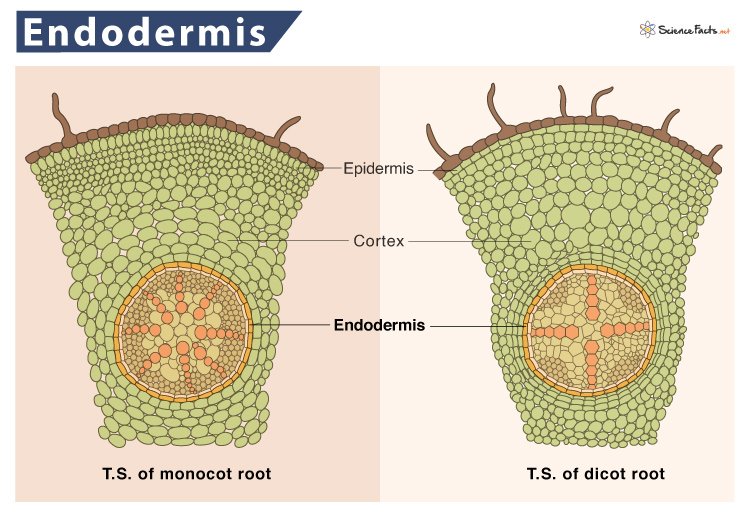Endodermis
The endodermis or the Casparian strip of endodermis is the tightly packed layer of cells that forms the innermost layer of the cortex in vascular land plants. It is located between the cortex and the vascular tissues, xylem, and phloem.
In some seedless plants (like ferns and mosses), the endodermis is a visible layer of cells immediately outside the vascular cylinder (stele) in roots and shoots. In woody, seeded plants, the endodermis is present only in the roots.
The endodermis serves as an impermeable barrier to the free diffusion of solutes from the soil into the stele. It thus helps to regulate the movement of water, ions, and hormones into and out of the vascular system.
Structure of Endodermis
- Consisting of single or multiple layers of compact, barrel-shaped cells without any intercellular spaces
- The cells typically have their primary cell walls thickened with suberin, deposited in distinctive bands called Casparian strips, hence the name Casparian strip of endodermis. In older cells, the suberin deposition is so extensive that the cells become lignified and completely waterproof.
- The Casparian strips vary in width but are typically smaller than the cell wall on which they are formed.
- If the endodermis is like a brick cylinder, where the bricks are cells, the Casparian strips are like mortars between the bricks.
Some dicot plants contain many amyloplasts (starch-containing plastids) in their endodermal cells. In that case, the endodermis of the dicot stem is also called a starch sheath.
What is the Function of the Endodermis
Main Function
It acts as an impermeable barrier, providing an obstacle to the passage of water and any dissolved solutes via the apoplastic pathway. Water can only pass through the endodermis twice, once while entering and again while leaving the cell.
Thus, endodermis allows the plant to control water flow in and out of the vascular tissues. Along with water, it also regulates the movement of ions and hormones that are dissolved in water.
Other Roles
- Storing reserve food as starch due to the presence of amyloplasts
- Preventing gas bubbles from entering the xylem, which keeps the water column continuous.
- Forming a waxy seal around a plan
- t’s vascular tissue prevents the entry of harmful organisms and chemicals into the plant. Difference between Endodermis and Epidermis
| Basis | Endodermis | Epidermis |
|---|---|---|
| Location | Innermost cell layer of the plant organs Found primarily in the roots and sometimes in the stem but absent in leaves | Outermost cell layer of the plant organsFound in leaves, stem, and roots |
| Depth of the Layer | Thin | Thick |
| Made of | Consisting of suberin and Casparian strip | Consisting of a cuticle |
| Functions | Separating the cortex from the vascular bundle.Regulating the entry and exit of water, ions, and hormones to and from the vascular system | Allowing gas exchangePreventing water loss |
-
References
Article was last reviewed on Friday, February 17, 2023




